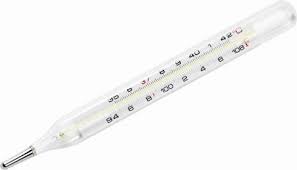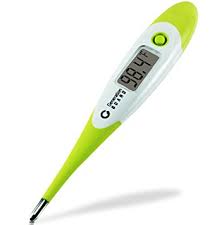The most familiar is the Liquid-in-glass thermometer
o As temperature rises or falls, the liquid (mercury or alcohol) becomes less or more dense, and expands or contracts.
o The amount of expansion is correlated with the temperature, so we can create a scale in Degrees Celsius.
<
o A probe contains a thermistor
o The resistance of the thermistor decreases as temperature increases, so any current though the thermistor will increase. Temperature and current are correlated, and a a temperature can be found for each level of resistance.
Over a narrow enough range of temperature, the degree of expansion for a liquid in gas thermometer, and the resistance for a thermistor, are approximately linearly correlated, which makes the temperature scale for a liquid in glass thermometer linear, and the calculations that must be performed for a digital thermometer simple.
<
o A probe contains two different metals joined metals to form 2 junctions.
o The temperature difference causes a tiny voltage and current. Larger temperatures create a greater current.
o A greater temp. difference gives a greater current.
o Thermocouple thermometers are suitable for high, rapidly changing temperatures(-200C° to 1100°C), and can red over a wide range.
